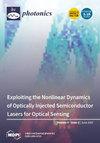On the Origin of the Photoplethysmography Signal: Modeling of Volumetric and Aggregation Effects
IF 2.1
4区 物理与天体物理
Q2 OPTICS
引用次数: 0
Abstract
This study aimed to examine the mechanisms of the photoplethysmography (PPG) signal formation using Monte Carlo simulations of light transport in biological tissues and experimental observations. Based on a three-layer skin model in backscattering geometry, we sequentially simulated volumetric blood changes and the aggregation/disaggregation of erythrocytes in the dermal layer and estimated their contribution to the registered PPG signal. The calculations were conducted for two wavelengths: 525 nm and 810 nm. For green light, absorption predominates over scattering in the formation of a PPG signal, whereas, for near-infrared light, scattering prevails over absorption. This theoretical result was verified using the Modified Beer–Lambert law and clinical in vivo PPG data of seven healthy subjects. Changes in the size of the scatterers during erythrocyte aggregation and disaggregation can significantly contribute to the PPG signal at near-infrared light. Thus, for the green waveband, the classical volumetric model can be considered dominant in the PPG signal formation. In contrast, for the near-infrared range, both volumetric and aggregation effects must be considered as being approximately equal.光敏血压信号的起源:体积和聚集效应建模
本研究旨在利用蒙特卡洛模拟生物组织中的光传输和实验观察来研究光生理盐水(PPG)信号的形成机制。基于反向散射几何的三层皮肤模型,我们依次模拟了血液的体积变化和真皮层中红细胞的聚集/解聚,并估算了它们对注册 PPG 信号的贡献。计算针对两种波长进行:525 纳米和 810 纳米。对于绿光,在 PPG 信号的形成过程中,吸收比散射更重要,而对于近红外线,散射比吸收更重要。这一理论结果通过改良比尔-朗伯定律和七名健康受试者的体内 PPG 临床数据得到了验证。红细胞聚集和分解过程中散射体大小的变化会对近红外光下的 PPG 信号产生显著影响。因此,对于绿色波段,经典的体积模型可被认为是 PPG 信号形成的主要因素。相反,在近红外波段,体积效应和聚集效应必须被视为大致相同。
本文章由计算机程序翻译,如有差异,请以英文原文为准。
求助全文
约1分钟内获得全文
求助全文
来源期刊

Photonics
Physics and Astronomy-Instrumentation
CiteScore
2.60
自引率
20.80%
发文量
817
审稿时长
8 weeks
期刊介绍:
Photonics (ISSN 2304-6732) aims at a fast turn around time for peer-reviewing manuscripts and producing accepted articles. The online-only and open access nature of the journal will allow for a speedy and wide circulation of your research as well as review articles. We aim at establishing Photonics as a leading venue for publishing high impact fundamental research but also applications of optics and photonics. The journal particularly welcomes both theoretical (simulation) and experimental research. Our aim is to encourage scientists to publish their experimental and theoretical results in as much detail as possible. There is no restriction on the length of the papers. The full experimental details must be provided so that the results can be reproduced. Electronic files and software regarding the full details of the calculation and experimental procedure, if unable to be published in a normal way, can be deposited as supplementary material.
 求助内容:
求助内容: 应助结果提醒方式:
应助结果提醒方式:


